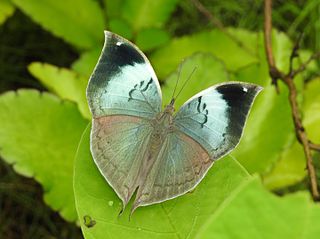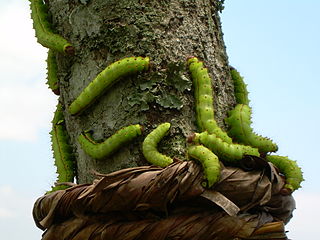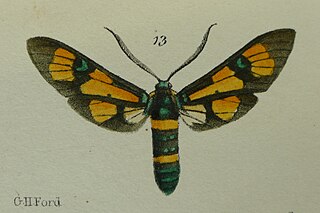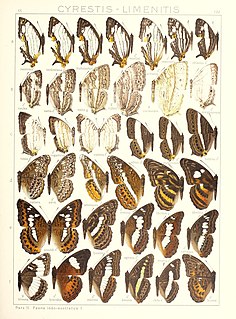
Bombyx mori, the domestic silk moth, is an insect from the moth family Bombycidae. It is the closest relative of Bombyx mandarina, the wild silk moth. The silkworm is the larva or caterpillar of a silk moth. It is an economically important insect, being a primary producer of silk. A silkworm's preferred food are white mulberry leaves, though they may eat other mulberry species and even the osage orange. Domestic silk moths are entirely dependent on humans for reproduction, as a result of millennia of selective breeding. Wild silk moths are not as commercially viable in the production of silk.

Thomas Horsfield M.D. was an American physician and naturalist who worked extensively in Indonesia, describing numerous species of plants and animals from the region. He was later a curator of the East India Company Museum in London.

Bombykol is a pheromone released by the female silkworm moth to attract mates. It is also the sex pheromone in the wild silk moth. Discovered by Adolf Butenandt in 1959, it was the first pheromone to be characterized chemically.
Bombyx is the genus of true silk moths or mulberry silk moths of the family Bombycidae, also known as silkworms, which are the larvae or caterpillars of silk moths. The genus was erected by Carl Linnaeus in his 1758 10th edition of Systema Naturae.

Allotinus horsfieldi, the common darkie, is a small butterfly found in India that belongs to the lycaenids or blues family.

Allotinus is a genus of butterflies in the family Lycaenidae. The genus was erected by Cajetan Felder and Rudolf Felder in 1865. The members (species) of this genus are found in the Indomalayan realm.

Mycalesis, the bushbrowns, are a genus of brush-footed butterflies. They are common in the warm regions from Central Asia to Australia, and have a high diversity in South Asia and the Wallacea.

The Bombycidae are a family of moths. The best-known species is Bombyx mori (Linnaeus) or silkworm, native to northern China and domesticated for millennia. Another well-known species is Bombyx mandarina, also native to Asia.
Fibroin is an insoluble protein present in silk produced by numerous insects, such as the larvae of Bombyx mori, and other moth genera such as Antheraea, Cricula, Samia and Gonometa. Silk in its raw state consists of two main proteins, sericin and fibroin, with a glue-like layer of sericin coating two singular filaments of fibroin called brins. Silk fibroin is considered a β-keratin related to proteins that form hair, skin, nails and connective tissues.

Kallima horsfieldii, the blue oakleaf, southern blue oakleaf or Sahyadri blue oakleaf, is a nymphalid butterfly found in India. The underside appears like a leaf complete with midrib while the upperside is brilliantly coloured.

Euchromia is a genus of moths in the subfamily Arctiinae. The genus was erected by Jacob Hübner in 1819.

Wild silks have been known and used in many countries from early times, although the scale of production is far smaller than that from cultivated silkworms. Silk cocoons and nests often resemble paper or cloth, and their use has arisen independently in many societies.

Euchromia horsfieldi is a species of moth in the subfamily Arctiinae first described by Frederic Moore in 1859. It is found on Java, Sumatra, Borneo, the Lesser Sunda Islands and Christmas Island.

Bombyx huttoni, or the chocolate-tipped silk moth, is a moth belonging to the silk moth family, Bombycidae. It is closely related to the domestic silk moth.

Lineopalpa horsfieldi is a species of moth of the family Erebidae first described by Achille Guenée in 1852. It is found in the Himalayas, Sumatra, Java, Borneo, Luzon, Sulawesi, Seram and New Guinea.

Bidensovirus is a genus of single stranded DNA viruses that infect invertebrates. The species in this genus were originally classified in the family Parvoviridae but were moved to a new genus because of significant differences in the genomes.
A micropyle is a pore in the membrane covering the ovum, through which a sperm enters. Micropyles are also found in sporozoites of some digenetic microorganisms such as Plasmodium at the anterior part of the cell that ultimately leads towards the apical cap. Examples of other organisms that have micropyles are the Bombyx mandarina and the Ceratitis capitata.

Cyrestis themire is a butterfly of the family Nymphalidae. It is found in the Malay archipelago.
Antheraea roylei is a large moth in the family Saturniidae occurring in Nepal, Thailand, Burma, Vietnam, West Malaysia, and the Himalayan regions of India. The species is considered to be the wild progenitor of the domesticated species known as Antheraea pernyi; the theory is that pernyi may have evolved from ancestral A. roylei by chromosome rearrangement during domestication.













